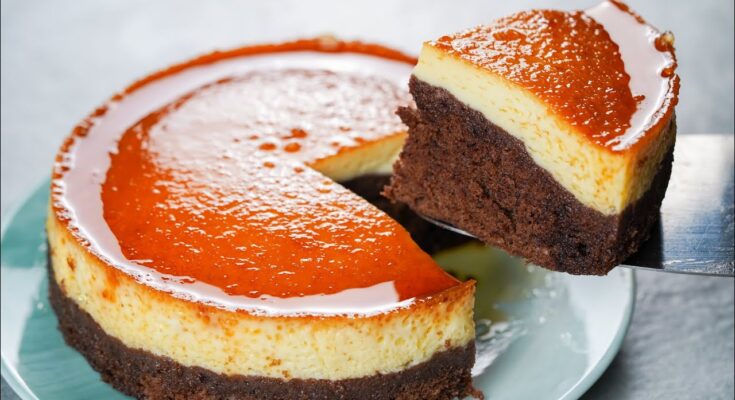Pudding Cake Recipe: There’s something irresistibly comforting about a pudding cake—a dessert that magically separates into two luscious layers while baking: a soft, tender cake on top and a rich, gooey pudding sauce underneath.
Whether you’re new to baking or a dessert enthusiast, this recipe will walk you through everything you need to know to make a perfect pudding cake from scratch. Let’s dive into the delightful world of warm, melt-in-your-mouth pudding cakes.
What Makes Pudding Cake Special?
Pudding cake is a dessert that seems almost magical in its transformation. When you pour the batter into the pan and bake it, it starts as one mixture—but somehow, during baking, it separates into two distinct layers: a moist, fluffy cake on top and a creamy, pudding-like sauce at the bottom. The secret lies in the liquid ratio and the self-saucing technique, which allows the dessert to create its own sauce as it bakes.
What makes pudding cake truly special is its versatility. You can enjoy it warm with a scoop of vanilla ice cream or chilled with whipped cream. It’s rich without being overly sweet and has a homemade comfort that feels nostalgic. Perfect for cozy evenings, family dinners, or even holiday gatherings, pudding cake never fails to impress.
Whether you love chocolate, lemon, or vanilla, this base recipe can be adapted into countless flavors—each one with that same signature soft and saucy texture that makes pudding cake so unique.
The Origin and Popularity of Pudding Cakes
The history of pudding cakes dates back to old-fashioned “self-saucing” desserts popular in British and American kitchens. The term “pudding” in the UK often refers to any sweet, baked dessert, while in the US, it means a creamy, custard-like treat. Pudding cake bridges both meanings perfectly—it’s a baked dessert that has both a cake and pudding element in one dish.
Over time, this recipe evolved into various regional favorites. The classic chocolate pudding cake became a staple in mid-century American cookbooks, while lemon pudding cake found its fame in Southern cuisine. Today, the dessert continues to gain popularity for its simple preparation and impressive results.
Unlike complex layered cakes, pudding cake doesn’t require frosting, decoration, or advanced baking skills. It’s a humble yet show-stopping dessert that anyone can make. With just a few pantry staples, you can whip up a dessert that looks and tastes like it took hours to prepare.
Ingredients You’ll Need
Basic Ingredients for the Cake Batter
To make the perfect pudding cake, you’ll need simple ingredients that you likely already have in your kitchen. Here’s what you’ll need for the cake layer:
- All-purpose flour – 1 cup (gives structure and light texture)
- Granulated sugar – ¾ cup (for sweetness and moisture)
- Unsweetened cocoa powder (for chocolate pudding cake) – ¼ cup
- Baking powder – 2 teaspoons (helps the cake rise)
- Salt – a pinch (enhances the flavors)
- Milk – ½ cup (adds richness and moisture)
- Butter (melted) – ¼ cup (gives the cake a tender crumb)
- Vanilla extract – 1 teaspoon (for depth of flavor)
Mixing these ingredients creates a smooth, thick batter that will rise beautifully over the pudding mixture. You can swap ingredients like butter for oil or regular milk for almond or oat milk depending on your dietary preferences.
Ingredients for the Pudding Layer
The pudding layer is what gives this dessert its “self-saucing” magic. It starts off as a simple mixture of sugar, cocoa, and hot water but turns into a silky pudding once baked.
You’ll need:
- Brown sugar – 1 cup (adds caramelized depth to the sauce)
- Unsweetened cocoa powder – ¼ cup (for chocolate version)
- Boiling water – 1 ¾ cups (to activate the sauce layer)
For non-chocolate versions, replace cocoa powder with lemon juice and zest for a tangy twist, or use caramel syrup for a rich butterscotch flavor. The hot water is poured over the batter right before baking—it seems odd, but this step is crucial. During baking, the liquid sinks to the bottom, creating the pudding layer while the cake rises to the top.
Optional Add-ons and Flavor Variations
Here’s where you can get creative with your pudding cake. Try mixing in:
- Chopped nuts – almonds, pecans, or walnuts add crunch.
- Chocolate chips – for an extra gooey center.
- Fruit – raspberries, cherries, or bananas pair wonderfully.
- Spices – cinnamon, nutmeg, or espresso powder for flavor depth.
For a festive touch, drizzle caramel sauce or dust with powdered sugar after baking. You can even add a splash of liqueur like Kahlúa or Baileys for a grown-up version.
Kitchen Tools and Equipment
Essential Baking Tools
To make this pudding cake, gather the following:
- Mixing bowls (medium and large)
- Measuring cups and spoons
- Whisk or hand mixer
- 8×8-inch baking dish (glass or ceramic preferred)
- Rubber spatula
- Kettle or saucepan (for boiling water)
Having the right tools ensures even mixing, proper baking, and easy cleanup. A glass baking dish helps you see the pudding layer form, while a whisk prevents lumps in your batter.
Helpful Tips for Preparing Your Workspace
Before you begin, preheat your oven to 350°F (175°C) and grease your baking dish lightly with butter or non-stick spray. Organize your ingredients and tools before mixing—this not only saves time but also ensures you don’t miss anything.
Keep a clean, dry towel handy for spills and use a heatproof mat for handling hot dishes. Baking can get messy, but a well-prepared space makes the process smooth and enjoyable.
Step-by-Step Guide to Making Pudding Cake
Step 1: Preparing Your Baking Dish
Preheat your oven to 350°F (175°C). Grease a medium-sized baking dish with butter or nonstick spray to prevent sticking. You can also lightly dust it with flour for extra protection. This step ensures your pudding cake releases easily after baking — no broken edges or messy scoops!
Step 2: Making the Cake Batter
In a mixing bowl, combine 1 cup of flour, ¾ cup of sugar, 2 teaspoons of baking powder, and a pinch of salt. In another bowl, whisk together ½ cup of milk, 2 tablespoons of melted butter, and 1 teaspoon of vanilla extract. Pour the wet ingredients into the dry ingredients and stir until just combined — don’t overmix. The batter should be smooth but not runny.
Step 3: Preparing the Pudding Mixture
In a separate bowl, mix 1 cup of brown sugar with ¼ cup of unsweetened cocoa powder (for chocolate pudding cake) or use instant pudding mix if preferred. Gradually whisk in 1½ cups of hot water or milk until fully dissolved. This mixture will form the luscious pudding layer at the bottom once baked.
Step 4: Combining Layers the Right Way
Pour the cake batter evenly into the prepared baking dish. Slowly pour the pudding mixture over the batter — do not stir! It may look odd now, but as it bakes, the pudding sinks to the bottom while the cake rises to the top, creating that magical two-layer dessert.
Step 5: Baking the Pudding Cake Perfectly
Place the dish in the oven and bake for 35–40 minutes, or until the top is set and slightly cracked. The cake should be fluffy on top and gooey underneath. Let it cool for 10 minutes before serving.
Serve warm with a scoop of ice cream or a dollop of whipped cream — every spoonful gives you soft cake above and silky pudding below. Pure comfort in a dish!
Cooling and Serving the Pudding Cake
How to Know When It’s Ready
The best way to tell if your pudding cake is ready is by looking for visual and textural clues. The top should appear firm, slightly crisp, and golden (or deep chocolate brown), while small bubbles may appear around the edges from the pudding sauce underneath.
If you gently shake the pan, the center should wobble slightly—this means the pudding layer is still soft and gooey. Once removed from the oven, let the cake rest for 10 to 15 minutes. This cooling period allows the sauce to thicken and the cake to stabilize, making it easier to serve.
You can also check readiness with a spoon test—gently scoop from one corner. You should see a fluffy cake layer on top and a glossy pudding layer underneath. If the pudding looks too runny, bake for an additional 5 minutes, but avoid overcooking, as it may cause the sauce to dry out.
Tips for Serving Warm or Cold
Pudding cake is best enjoyed warm, right out of the oven, when the sauce is molten and the cake is tender. Serve it in small bowls or ramekins, making sure to scoop deep enough to include both layers. Top it with vanilla ice cream, whipped cream, or a dusting of powdered sugar for a perfect finish.
However, if you prefer a cooler dessert, refrigerate it for a few hours before serving. Once chilled, the pudding layer thickens into a creamy custard-like texture, offering a completely different but equally delightful experience.
For an elegant twist, drizzle with caramel or chocolate syrup, add fresh fruit, or sprinkle toasted nuts on top. No matter how you serve it, pudding cake is the kind of dessert that brings comfort and smiles with every bite.
Flavor Variations to Try
Pudding cake is one of those desserts that never gets boring because it’s endlessly customizable. Whether you crave something rich and chocolaty, tangy and citrusy, or sweet and buttery, there’s a pudding cake variation for every taste bud. Here are some irresistible flavor options you can easily make at home.
Chocolate Pudding Cake
The classic chocolate pudding cake is the most popular and indulgent version of this dessert. It combines the richness of cocoa with a silky chocolate sauce that forms naturally while baking.
To make it, follow the base recipe but be generous with the cocoa powder. Use ½ cup of unsweetened cocoa powder instead of ¼ cup for an extra-deep chocolate flavor. You can also replace part of the milk with strong brewed coffee or espresso—this enhances the chocolate taste without making it bitter.
For a gooey, decadent texture, add ½ cup of semi-sweet chocolate chips into the batter before baking. They’ll melt inside, creating molten chocolate pockets that blend perfectly with the pudding sauce.
Once baked, top the cake with a scoop of vanilla ice cream or whipped cream. For an extra touch, dust it with cocoa powder or drizzle it with warm chocolate ganache. Every bite will feel like a luxurious spoonful of molten lava cake—only easier to make!
Lemon Pudding Cake
If you prefer something bright, tangy, and refreshing, lemon pudding cake is a delightful twist. Instead of cocoa, this version uses lemon juice and zest to create a creamy, citrusy pudding layer.
To make it, replace cocoa powder in both the batter and pudding mixture with 2 tablespoons of lemon zest and ⅓ cup of fresh lemon juice. You can also add a teaspoon of vanilla or almond extract to balance the tartness.
During baking, the lemon flavor intensifies, and the pudding layer becomes like a smooth lemon curd. Serve it with a dusting of powdered sugar or a dollop of whipped cream for a restaurant-quality dessert.
Lemon pudding cake is light enough for spring and summer but comforting enough for any season. It’s especially great after rich or heavy meals—each bite feels like a burst of sunshine!
Vanilla or Caramel Pudding Cake
For something subtle and sweet, vanilla or caramel pudding cake offers a buttery, melt-in-your-mouth experience. This variation replaces cocoa with vanilla extract, brown sugar, and a hint of caramel for a golden, luscious dessert.
To make it, omit the cocoa and add 2 teaspoons of pure vanilla extract to the batter. For the pudding layer, mix 1 cup brown sugar with 1 tablespoon cornstarch and pour 1¾ cups of boiling water mixed with 2 tablespoons caramel syrup over it before baking.
As it bakes, you’ll get a beautifully golden cake with a caramel pudding sauce bubbling beneath. The aroma is divine—sweet, buttery, and comforting. Serve warm with vanilla ice cream or sprinkle some sea salt on top for a salted-caramel twist.
Expert Tips for a Perfect Pudding Cake Every Time
Making pudding cake is easy, but a few expert tricks can take it from good to absolutely perfect. These tips will help you master the technique and customize your dessert for the best flavor and texture possible.
Avoiding Common Mistakes
- Don’t Overmix the Batter – Once the wet and dry ingredients are combined, stop mixing. Overmixing makes the cake dense instead of light and fluffy.
- Never Stir the Layers – After pouring the hot water over the sugar mixture, don’t mix it. The layering is essential for creating that self-saucing effect.
- Use Boiling Water, Not Warm – The temperature of the water matters! Boiling water helps dissolve the sugar quickly and activates the sauce as it bakes.
- Bake in the Right Dish – Glass or ceramic dishes work best because they distribute heat evenly and allow you to see the sauce forming underneath.
- Don’t Overbake – The pudding layer can dry out if baked too long. The cake is ready when the top looks set, but the bottom is still soft and gooey.
- Cool Before Serving – Allowing the cake to rest for 10–15 minutes after baking helps the sauce thicken slightly and enhances the flavor.
These small adjustments can make a huge difference between a soggy cake and a beautifully layered pudding masterpiece.
Adjusting Ingredients for Dietary Needs
Pudding cake is easily adaptable for different diets and preferences. Here’s how you can modify it without losing flavor or texture:
- Gluten-Free: Substitute all-purpose flour with a 1:1 gluten-free baking blend. Almond flour can also work for a nutty flavor.
- Dairy-Free: Use plant-based milk (almond, soy, or oat milk) and replace butter with coconut oil or vegan margarine.
- Low-Sugar: Swap part of the sugar with natural sweeteners like stevia, monk fruit, or coconut sugar. Keep in mind that this may slightly change the texture of the pudding layer.
- Egg-Free: Most pudding cake recipes don’t need eggs, making them perfect for vegan baking. But if your variation calls for one, replace it with ¼ cup of applesauce or mashed banana.
With these simple swaps, everyone can enjoy pudding cake—no matter their dietary needs.
Storage and Reheating Instructions
Even though pudding cake tastes best fresh out of the oven, you can easily store and reheat leftovers while keeping the same delicious texture.
How to Store Leftovers Properly
Once the cake has cooled completely, cover it tightly with plastic wrap or transfer it to an airtight container. Store it in the refrigerator for up to 3 days. The pudding layer will thicken as it chills, becoming more like custard—but it’ll still taste amazing.
Avoid leaving pudding cake out at room temperature for too long, especially if your kitchen is warm. The pudding layer can spoil quickly due to its moisture content.
If you plan to store it longer, you can freeze individual portions. Place them in freezer-safe containers or bags and freeze for up to 2 months. When ready to enjoy, thaw overnight in the fridge before reheating.
Best Ways to Reheat Without Losing Texture
To reheat pudding cake, you have two main options—microwave or oven:
- Microwave: Place a portion in a microwave-safe dish and heat on medium for 30–45 seconds. Be careful not to overheat, or the pudding layer may dry out.
- Oven: Preheat to 300°F (150°C) and warm the cake in a covered baking dish for 10–15 minutes. This helps retain the soft, saucy texture.
If you stored your pudding cake in the fridge, add a tablespoon of milk or cream before reheating to revive its moisture. For an indulgent twist, serve it with a drizzle of caramel or a scoop of ice cream after warming.
Nutritional Information (Approximate)
While pudding cake is a comfort dessert, it’s always good to know what’s inside each serving. Here’s an approximate nutritional breakdown for a chocolate pudding cake serving (based on 8 servings):
| Nutrient | Amount per Serving |
|---|---|
| Calories | 320 kcal |
| Carbohydrates | 52 g |
| Sugar | 35 g |
| Protein | 4 g |
| Fat | 12 g |
| Saturated Fat | 7 g |
| Fiber | 2 g |
| Sodium | 180 mg |
Keep in mind that values can vary depending on ingredient brands, portion sizes, and substitutions (like plant-based milk or sugar alternatives).
FAQs about Pudding Cake Recipe
1. Can I use instant pudding mix for this recipe?
It’s not recommended. Instant pudding mix won’t create the self-saucing effect. Stick to the original method where the pudding forms naturally as the cake bakes.
2. How can I make this cake dairy-free or gluten-free?
Use plant-based milk (like almond or oat) and gluten-free flour. Replace butter with coconut oil for a dairy-free version.
3. What’s the difference between pudding cake and lava cake?
Lava cake has a molten chocolate center created by underbaking, while pudding cake naturally separates into two distinct layers: cake on top, pudding on the bottom.
4. Can I make pudding cake ahead of time?
Yes! Bake it a day ahead and refrigerate. Reheat gently before serving for that fresh-from-the-oven texture.
5. How do I prevent the pudding layer from sinking?
Don’t stir after pouring the hot water on top. The layers will naturally invert while baking—just trust the process!
Conclusion
Pudding cake is the perfect blend of simplicity and indulgence—a dessert that practically makes itself. With its tender cake layer and smooth, self-made pudding sauce, it’s a true crowd-pleaser that never goes out of style. Whether you’re craving chocolate, lemon, or caramel, you can whip up this treat with just a few pantry staples and minimal effort.
The best part? Every spoonful feels like a hug in dessert form—warm, soft, and wonderfully nostalgic. So the next time you want a sweet treat that’s quick, comforting, and utterly satisfying, skip the boxed mix and make your own homemade pudding cake.



